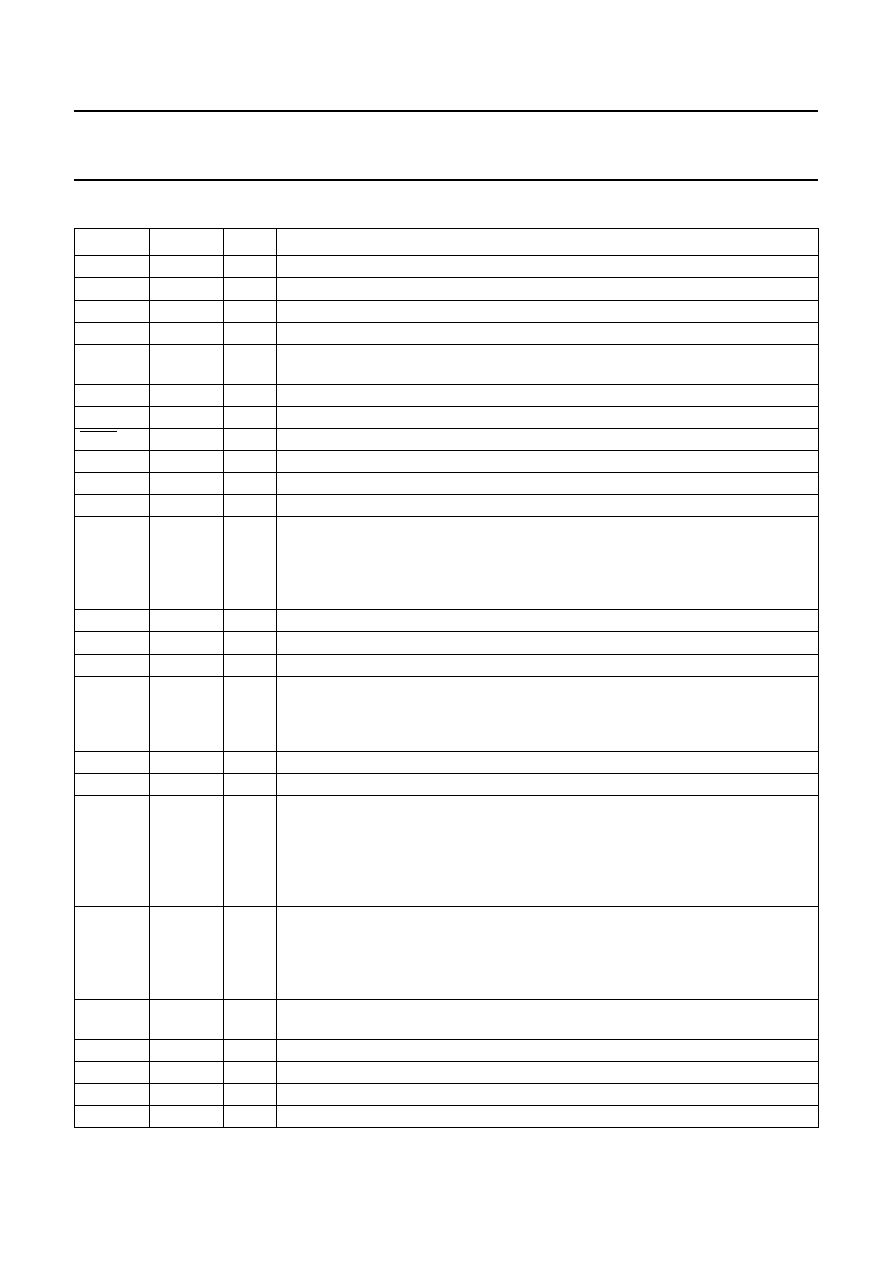- 您現(xiàn)在的位置:買賣IC網(wǎng) > PDF目錄36337 > 935261504557 (NXP SEMICONDUCTORS) SPECIALTY CONSUMER CIRCUIT, PQFP44 PDF資料下載
參數(shù)資料
| 型號: | 935261504557 |
| 廠商: | NXP SEMICONDUCTORS |
| 元件分類: | 消費(fèi)家電 |
| 英文描述: | SPECIALTY CONSUMER CIRCUIT, PQFP44 |
| 封裝: | PLASTIC, SOT-307, QFP-44 |
| 文件頁數(shù): | 56/87頁 |
| 文件大小: | 440K |
| 代理商: | 935261504557 |
第1頁第2頁第3頁第4頁第5頁第6頁第7頁第8頁第9頁第10頁第11頁第12頁第13頁第14頁第15頁第16頁第17頁第18頁第19頁第20頁第21頁第22頁第23頁第24頁第25頁第26頁第27頁第28頁第29頁第30頁第31頁第32頁第33頁第34頁第35頁第36頁第37頁第38頁第39頁第40頁第41頁第42頁第43頁第44頁第45頁第46頁第47頁第48頁第49頁第50頁第51頁第52頁第53頁第54頁第55頁當(dāng)前第56頁第57頁第58頁第59頁第60頁第61頁第62頁第63頁第64頁第65頁第66頁第67頁第68頁第69頁第70頁第71頁第72頁第73頁第74頁第75頁第76頁第77頁第78頁第79頁第80頁第81頁第82頁第83頁第84頁第85頁第86頁第87頁

1999 Jul 01
6
Philips Semiconductors
Product specication
9-bit video input processor
SAA7113H
7
PINNING
SYMBOL
PIN
I/O/P
DESCRIPTION
AI22
1
I
analog input 22
VSSA1
2
P
ground for analog supply voltage channel 1
VDDA1
3
P
positive supply voltage for analog channel 1 (+3.3 V)
AI11
4
I
analog input 11
AI1D
5
I
differential analog input for AI11 and AI12; has to be connected to ground via a
capacitor; see application diagram of Fig.31
AGND
6
P
analog signal ground connection
AI12
7
I
analog input 12
TRST
8
I
test reset input (active LOW), for boundary scan test; notes 1, 2 and 3
AOUT
9
O
analog test output; for testing the analog input channels, 75
termination possible
VDDA0
10
P
positive supply voltage (+3.3 V) for internal Clock Generation Circuit (CGC)
VSSA0
11
P
ground for internal clock generation circuit
VPO7 to
VPO4
12 to 15
O
digital VPO-bus output signal; higher bits of the 8-bit output bus. The output data
types of the VPO-bus are controlled via I2C-bus registers LCR2 to LCR24;
see Table 4. If I2C-bus bit VIPB = 1, the higher bits of the digitized input signal are
connected to these outputs, congured by the I2C-bus control signals
MODE3 to MODE0
VSSDE1
16
P
ground 1 or digital supply voltage input E (external pad supply)
LLC
17
O
line-locked system clock output (27 MHz)
VDDDE1
18
P
digital supply voltage E1 (external pad supply 1; +3.3 V)
VPO3 to
VPO0
19 to 22
O
digital VPO-bus output signal; lower bits of the 8-bit output bus. The output data types
of the VPO-bus are controlled via I2C-bus registers LCR2 to LCR24; see Table 4.
If I2C-bus bit VIPB = 1, the lower bits of the digitized input signal are connected to
these outputs, congured by the I2C-bus control signals MODE3 to MODE0
SDA
23
I/O
serial data input/output (I2C-bus) 5 V-compatible
SCL
24
I
serial clock input (I2C-bus) 5 V-compatible
RTCO
25
(I/)O
real-time control output: contains information about actual system clock frequency,
eld rate, odd/even sequence, decoder status, subcarrier frequency and phase and
PAL sequence (see external document
“RTC Functional Description”, available on
request); the RTCO pin is enabled via I2C-bus bit OERT; this pin is also used as an
input pin for test purposes and has an internal pull-down resistor; do not
connect any pull-up resistor to this pin
RTS0
26
(I/)O
real-time signal output 0: multi functional output, controlled by I2C-bus bits
RTSE03 to RTSE00; see Table 49. RTS0 is strapped during power-on or CE driven
reset, denes which I2C-bus slave address is used; 0 = 48H for write, 49H for read,
external pull-down resistor of 3.3 k
is needed; 1 = 4AH for write, 4BH for read,
default slave address (default, internal pull-up)
RTS1
27
I/O
real-time signal I/O terminal 1: multi functional output, controlled by I2C-bus bit
RTSE13 to RTSE10; see Table 50
VSSDI
28
P
ground for internal digital core supply
VDDDI
29
P
internal core supply (+3.3 V)
VSSDA
30
P
digital ground for internal crystal oscillator
XTAL
31
O
second terminal of crystal oscillator; not connected if external clock signal is used
相關(guān)PDF資料 |
PDF描述 |
|---|---|
| 935261537118 | DELTA-SIGMA ADC, PDSO16 |
| 935261537112 | DELTA-SIGMA ADC, PDSO16 |
| 935261615112 | SPECIALTY CONSUMER CIRCUIT, PDSO28 |
| 935261615118 | SPECIALTY CONSUMER CIRCUIT, PDSO28 |
| 935261616112 | SPECIALTY CONSUMER CIRCUIT, PDIP32 |
相關(guān)代理商/技術(shù)參數(shù) |
參數(shù)描述 |
|---|---|
| 935262025112 | 制造商:NXP Semiconductors 功能描述:SUB ONLY IC |
| 935262217118 | 制造商:NXP Semiconductors 功能描述:Real Time Clock Serial 8-Pin SO T/R |
| 935264217557 | 制造商:NXP Semiconductors 功能描述:SUB ONLY IC |
| 935267356112 | 制造商:NXP Semiconductors 功能描述:IC TEA1507PN |
| 935268081112 | 制造商:NXP Semiconductors 功能描述:SUB ONLY IC |
發(fā)布緊急采購,3分鐘左右您將得到回復(fù)。